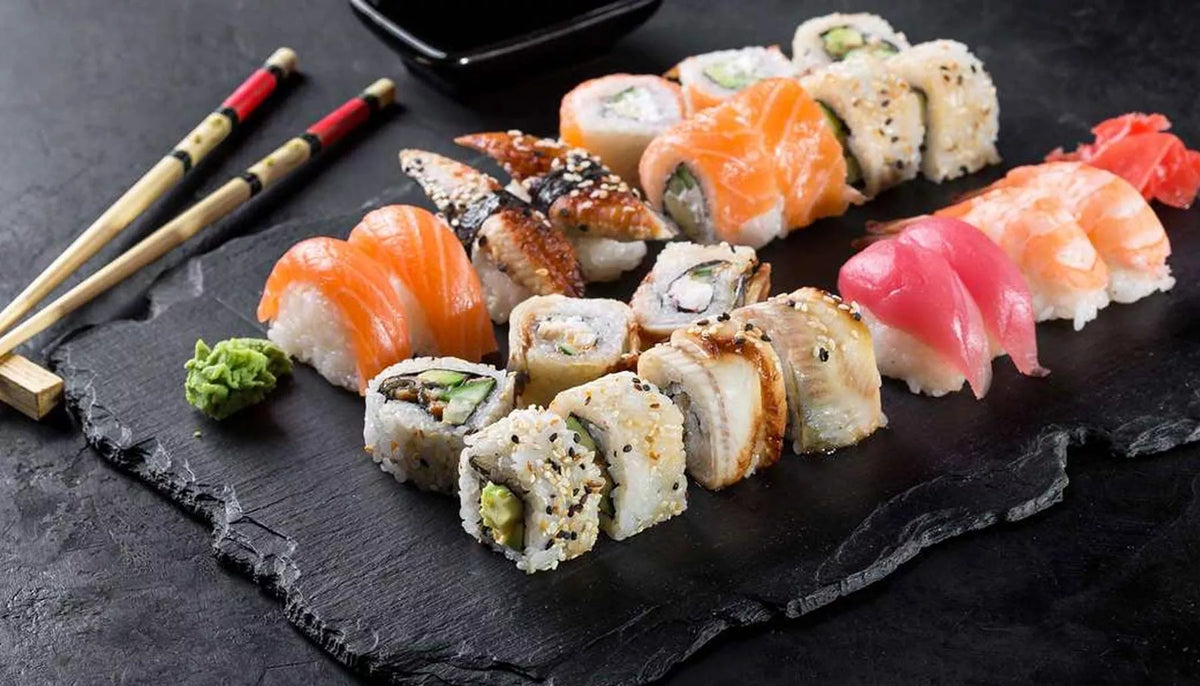
Why Do I Get Acid Reflux After Eating Sushi?
|
|
Time to read 4 min
|
|
Time to read 4 min
Sushi is often seen as a light, healthy meal - but for some, it unexpectedly leads to acid reflux or heartburn. If you've experienced a burning sensation in your chest or throat after eating sushi, you're not alone. This blog breaks down the potential triggers in sushi that may lead to acid reflux and outlines practical steps to help you enjoy sushi more comfortably.
Disclaimer: The information provided in this blog post is for general knowledge and informational purposes only, and does not constitute medical advice. Always consult with a qualified healthcare professional before making any decisions about your health or treatment. If you experience persistent or severe acid reflux, seek medical attention immediately.
Sushi is often light and nutritious, but several ingredients and eating habits associated with sushi can provoke acid reflux - especially in individuals with sensitive digestion or underlying gastrointestinal conditions. Below are the most common causes:
Many sushi rolls include wasabi, sriracha mayo, or spicy tuna blends - all of which contain irritants that can inflame the esophageal lining. Spicy ingredients are known triggers for acid reflux, especially when consumed in larger amounts or on an empty stomach.
Soy sauce is high in sodium and mildly acidic due to fermentation. High sodium can increase fluid retention and stomach pressure, contributing to reflux, while its acidity may further irritate sensitive individuals. Using low-sodium soy sauce or alternative seasonings can help reduce symptoms.
Most raw fish used in sushi, such as salmon or tuna, is generally lean and does not directly trigger acid reflux in most people. However, certain sushi options made with higher-fat fish (like fatty tuna "toro" or eel "unagi") or rolls containing fried ingredients or heavy sauces can increase acid reflux risk because fat slows digestion and relaxes the lower esophageal sphincter.
To understand and tackle why eating sushi causes acid reflux, remember: your digestive system is unique. Generic fixes rarely work because your triggers and gut sensitivity vary. For personalized answers and practical steps to truly improve your gut health, take our free, 2-minute sushi quiz. It uncovers your unique reflux patterns and guides you to lasting relief.
Sushi rice is seasoned with rice vinegar, which is mildly acidic and may cause irritation in sensitive individuals. Eating large quantities of rice can distend the stomach, increasing abdominal pressure that can push stomach acid upward. Multiple rolls or large portions in one sitting can worsen acid reflux symptoms. Moderating portion size and being mindful of acidity can help reduce discomfort.
Pairing sushi with sparkling water, soda, or green tea may further contribute to acid reflux. Carbonation increases pressure, and caffeine in tea may relax the LES, which can allow acid to escape from the stomach into the esophagus.
Experiencing reflux after sushi doesn't necessarily mean you need to give it up altogether. Here are evidence-informed strategies to reduce your chances of discomfort from acid reflux:
Opt for rolls with fewer ingredients, especially those that avoid spicy sauces, deep-fried components, or high-fat fillings. Cucumber rolls, salmon-avocado rolls (in moderation), or tuna sashimi may be easier to tolerate.
Use soy sauce sparingly - or choose low-sodium versions - and avoid loading wasabi onto each bite. Reducing sodium and spice can lessen irritation and prevent excessive acid production.
Choose sushi rolls made with lean fish such as salmon or tuna, as these are lower in fat and less likely to cause acid reflux. Avoid rolls with fried ingredients (such as tempura) or heavy mayonnaise-based sauces, which are higher in fat and more likely to trigger acid reflux symptoms.
Stick to 1–2 rolls per meal (or an equivalent amount of sashimi), especially if you're sensitive to large meals. A smaller meal reduces gastric pressure and improves digestion efficiency.
Eat sushi slowly and chew thoroughly. Rapid eating or swallowing large pieces increases abdominal pressure and may worsen acidreflux symptoms. Enjoy your meal mindfully and stop eating when you feel about 75% full to prevent overloading your stomach and worsening acid reflux.
Sushi can be a nutritious and enjoyable meal, but for individuals prone to acid reflux, certain ingredients and eating habits may contribute to post-meal discomfort. By making informed choices - such as limiting spicy sauces, moderating portion sizes, and avoiding high-sodium condiments - you can reduce the risk of acid reflux.
Sushi can trigger acid reflux due to spicy sauces, sodium, vinegar, or large portion sizes.
Eating quickly or pairing sushi with carbonated drinks can further increase symptom risk.
Choose low-fat, low-sodium options and eat slowly to reduce post-meal discomfort.
Limit wasabi, soy sauce, and high-acid beverages like green tea.
Ready for personalized relief for acid reflux? Complete Claisen's gut health quiz to identify your unique reflux triggers and receive evidence-based recommendations tailored to your digestive profile.
Not necessarily, but certain types - like spicy rolls, fried tempura, or high-fat fish - can worsen reflux symptoms. Individuals with GERD should opt for simple rolls and eat smaller portions.
Cucumber rolls
Avocado rolls (small portion)
Tuna or salmon sashimi
Rolls without spicy sauces or fried components
Not necessarily. Many individuals can enjoy sushi by adjusting what and how they eat. Focus on simpler ingredients, avoid trigger add-ons, and monitor your body's responses.
